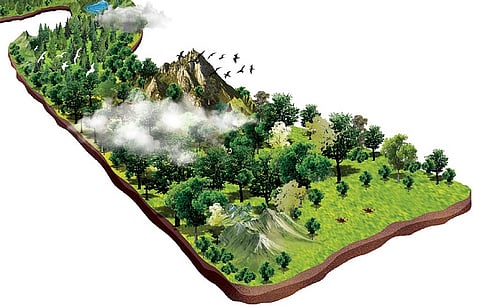

Kerala has recorded a fall in carbon stock over the past six years even as its forest cover has expanded, according to the ‘Environmental Accounting on Forest 2025’ report released by the National Statistics Office (NSO).
The state’s total carbon stock declined from 256 million tonnes in 2017 to 214 million tonnes in 2023. This drop comes despite an increase in the state’s forest growing stock – the total volume of trees – from 152 million cubic metres in 2013 to 169 million cubic metres in 2023, reports Rahul R of The New Indian Express.
During the same period, Kerala also registered a sharp rise in forest area, particularly in very dense and open forest categories. The area under very dense forest (canopy cover above 70%) rose from 1,529 sq km in 2010-11 to 2,041 sq km in 2021-22. Open forest (canopy cover between 10% and 40%) expanded from 6,992 sq km to 10,696 sq km.
Experts say this paradox -- more forest area but less carbon stock -- points to deeper ecological problems.
“The increase in trees does not automatically translate into higher carbon stock. Factors like forest degradation, replacement of natural forests with monoculture plantations, and changes in soil quality could be reducing the overall carbon retention capacity,” said Jayakumar C, executive director of Thanal, a Kerala-based environmental NGO.
“The carbon stock is linked to climate resilience. A fall of this scale weakens Kerala’s natural buffer against rising temperatures. Low carbon stock affects biodiversity and makes the region more vulnerable to climate disasters and extreme heat,” he added.
Much of the open forests in Kerala are now dominated by grasses, shrubs, and small trees, Jayakumar pointed out.
“The canopy cover is low. The government should invest in converting these lands into dense forests and ensure effective implementation of reforestation and restoration programmes,” he said. Jayakumar stressed on payment for resources -- paying the people for maintaining forest, water bodies, and other ecosystems that provide environment benefits to society. He also suggested the implementation of the payment-for-resource model for communities in districts, like Idukki, which provide vital ecosystem resources to other parts of the state.
Ecologist and Help Foundation director Peter Pradeep, based in Kollam, said the apparent increase in forest cover could be misleading.
“The rise may come from plantations and orchards rather than natural forests. These areas meet the technical definition of tree cover but lack ecological value. This way, forest cover may have expanded but trees are thinner and have low biomass. The thickness and girth of trees is crucial for carbon sequestration. Only through effective carbon sequestration can we build up carbon stock. Without it, the rise in forest cover means little in terms of actual carbon stock,” Peter said.
He called for a social audit of the state’s conservation programmes.
“Large sums are being spent on forest conservation, but the results are negligible. A social audit will reveal how much money is spent and what outcomes are achieved. Only then can efforts to improve carbon stock be meaningful,” he added.
Forest Minister A K Saseendran said the NSO report will be analysed and necessary action taken.
“We will discuss the matter with the officials concerned. The action necessary will then be taken to improve the carbon stock,” the minister said.
What is carbon stock?
Carbon stock is the amount of carbon contained in a reservoir at a given point in time
The reservoir could be forests, oceans, or even soil, where carbon could be stored in solid, liquid or gaseous forms
Decline in carbon stock implies that the rate of release of stored carbon is faster than the rate of its absorption. This could be caused due to deforestation, agricultural expansion, etc.
What happens when carbon stock falls?
Weakening of carbon stocks could lead to the release of stored carbon dioxide into the atmosphere
This could, in turn, increase the greenhouse effect and climate change.
Reduced carbon stock could also be an indication of ecosystem degradation
